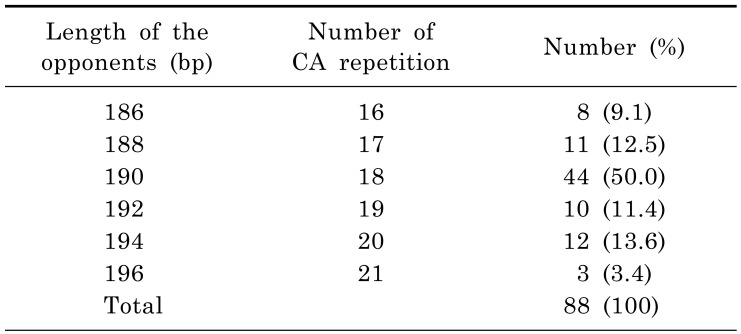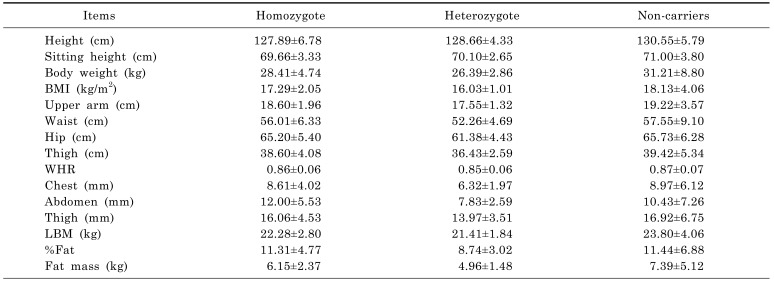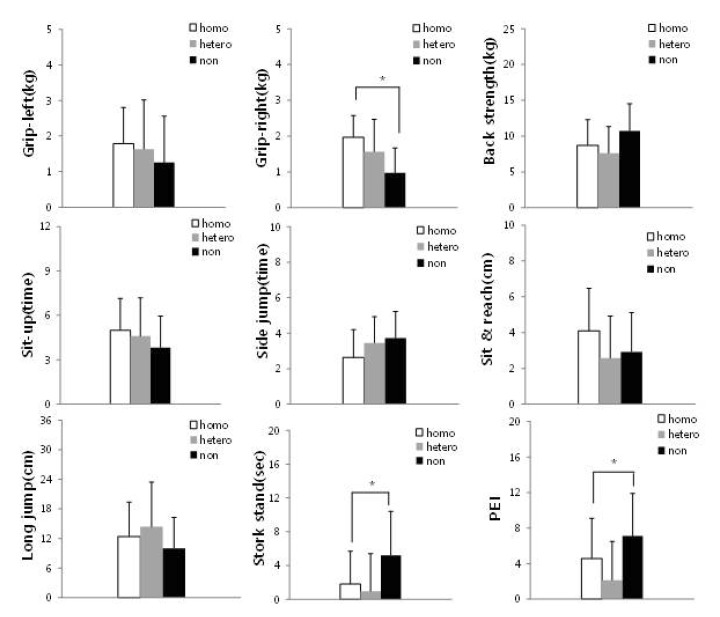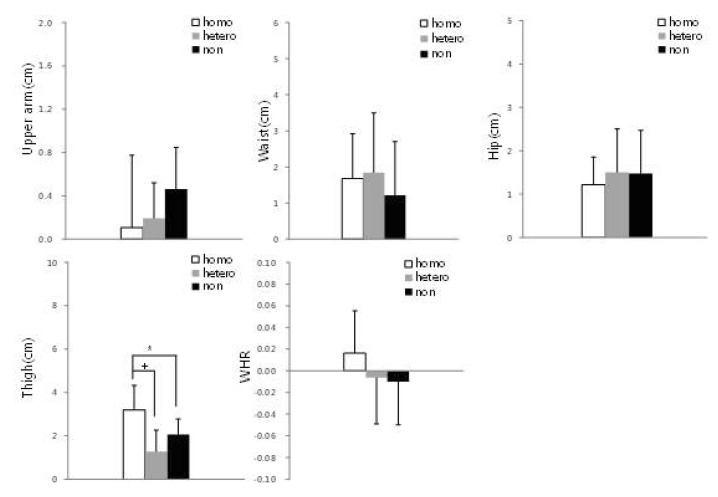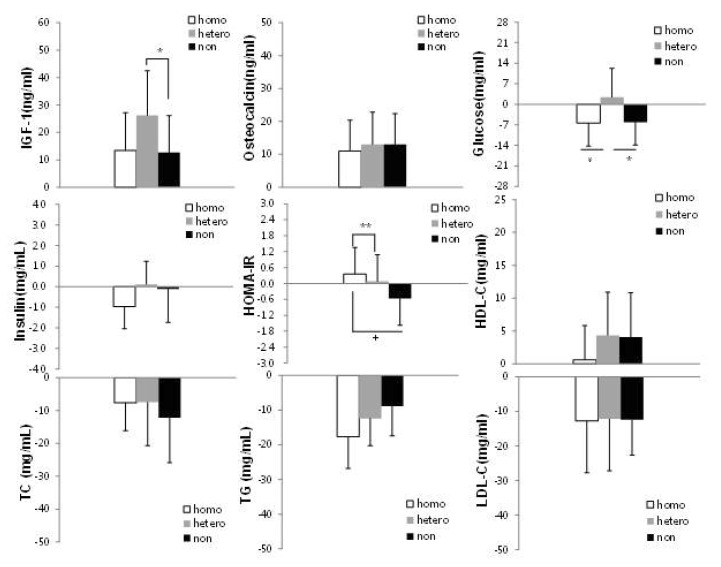Abstract
This study analyzed the effect of regular Taekwondo training for 16 weeks on physical fitness and growth index depending on different IGF-1 gene polymorphisms. The subjects of the study were 44 male students who were 8 year years old. The IGF-1 gene showed the highest frequency of 18 CA repeat (190 bp) in 50% of subjects, and was found in the homozygote (n=11), heterozygote (n=22) and non-carriers (n=11). The results of the physical fitness and growth index among the gene polymorphism groups indicated no significant differences but the expected height of the non-carrier group was significantly high (p<0.05). After Taekwondo training, the homozygote group and the non-carrier groups demonstrated significant (p<0.05) increase in grip strength and in time in the standing with one leg while closing eyes test, respectively. Only the homozygote group had a significant (p< 0.05) increase in thigh circumference. IGF-1 concentration significantly (p<0.05) increased in the heterozygote group, while HOMA-IR significantly (p<0.05) decreased in the homozygote group. Furthermore, there was a significant (p<0.05) decrease in glucose in both the homozygote and the non-carriers groups. The difference between physical fitness and growth index depending on the IGF-1 gene polymorphism after Taekwondo training did not show consistent impact.
Keywords: Elementary school students, Growth index, IGF-1 gene polymorphism, Physical fitness, Taekwondo training
INTRODUCTION
Taekwondo has been propagated worldwide and is currently a popular sport reaching about 70 million practitioners in 204 countries [1]. The number of children who join the Taekwondo training increases every year, with 380,000 applying for the Taekwondo belt test on an annual basis. Most of the prior studies related to the sport mainly focus how to improve the performance of athletes. However, the studies on how Taekwondo training affects the physical fitness and the growth index depending on the IGF-1 gene polymorphism of children during their growth period are scarce. That is, the insulin-like growth factor-1 (IGF-1), an important factor in the physiological mechanism which affects child growth, is controlled by the growth hormone (GH) and also involved in growth stimulation [2]. It is known to be a significant factor in the growth and development of the cell, plays a vital role in adjusting the growth of the bones, muscles and other tissues [3], increases the muscular protein contents, stimulates the skeletal muscle expansion, affects the insulin sensitivity and related glucose infusion in the muscles [4] and enhances the physical structure, muscle quantity and physical fitness level of children [5]. The IGF-1 gene with 70 amino acids is located in the 12th chromosome and comprised of 6 exons and 2 promoters. The cytosine-adenosine dinucleotide (CA) repeat exists on the 5' untranslated region (UTR) of exon 1, where transcription starts and gene polymorphism exists depending on the length difference from the number of repetitions [6].
The aim of the study was to investigate the difference between physical fitness and growth index depending on the IGF-1 gene polymorphism, and analyze them after a 16-week regular Taekwondo training. Also, this study aimed to check, on the genetic level, the effect of Taekwondo training on children's growth, which would serve as an important background for proposing genetic feature analysis that may be applied to solve the problems in the children's growth period.
METHODS
Subjects
The participants in the study were 55 male elementary school students, who were 8 years old. They joined the Taekwondo training from the elementary schools of B and D in the city of K in Gyeongbuk Province. A total of 44 subjects completed the experiment. Taekwondo training ran for 16 weeks, 50 minutes a day, and 5 times a week. Informed consent was obtained from the parents of the participants prior to carrying out the designated experiment. The study protocol was in compliance with the Code of Ethics of the World Medical Association (Declaration of Helsinki), and has been approved by the Institutional Review Board of the Keimyung University (IRB NO 11-233).
Measurement and methods
1. Physical characteristics and body composition
Standing height, sitting height, weight, overall fat and body fat were measured using InBody 3.0 (Biospace, Korea), and the body mass index (BMI) was calculated with the formula of 'weight/height2 (kg/m2)'. Subcutaneous fat was measured from the femoral region, triceps brachii and upper part of the iliac crest to the precision of 0.1 mm using the skinfold caliper (Skyndex, USA). Body fat ratio was calculated by the formula for the ratio using the thickness of the subcutaneous fat. The circumferences of the upper arm, waist, hip and thigh were measured. Waist circumference was measured based on the WHO standard which measures between the lower part of the 12th rib and the mid-part of the iliac crest, and the waist and the hip circumferences are measured to calculate the waist hip ratio (WHR).
2. Blood concentration of parameters
The subjects were asked to fast for 12 hours before a blood sample was taken from the antecubital vein. IGF was measured by the Chemilumino Immuno Assay (CLIA) using the Human IGF-1 ELISA Kit (ELH-IGF-1001, RarBio, Norcross, GA, USA), and osteocalcin was analyzed by the enzymelinkedimmunosorbent assay (ELISA) reader (Biotek, USA) using the Novo Clacin Kit (Meta Biosystem, Inc USA). Insulin and glucose concentrations were measured by the Immunoradiometric Assay and the glucose oxidase method, respectively using the INSULIN-IRMA (Gwangwon, Korea) sample for the insulin measurement. The Homeostasis model assessment (HOMA-IR) was calculated using the formula for insulin resistance (fasting insulin (µU/ml) × fasting glucose (mmol/liter)/22.5). The lipid factor concentration in the blood was calculated by analyzing the absorbance from the COBAS MIRA PLUS in each analysis kit (SICDIA LT-CHO REAGENT, Shinyang Chemical INC, Korea/HDL-C, LDL-C plus, Roche, Germany/SICDIA L TG REAGENT, Roche, Germany) for the total cholesterol (TC), triglyceride (TG), high-density lipoprotein cholesterol (HDL-C) and low-density lipoprotein cholesterol (LDL-C).
3. Genotype of IGF-1
5 ml of the peripheral blood was taken from the subjects for genetic analysis and the separated genomic DNA was melted by 10 mMTris (Base) of the TE buffer solution and 1 mM EDTA (Disodium, Dihydrate) with the pH between 7.0 and 7.4, measured by the spectrophotometer and stored at -20℃. The IGF-1 gene analysis followed the method of Larsen et al. [7] and the polymerase chain reaction (PCR) was implemented to amplify the confirmed DNA, showing that the forward primer was FAM-5'-GCTAGCCAGCTGGTGTTATT-3' and the backward primer was 5'-ACCACTCTGGGAGAAGGTA-3'. The PCR was 1.5 mM MgCl2, 200 µM dNTP, for each 0.4 µmM forward and backward primer, platinum Taq DNA polymerase (Invitrogen, Carlsbad, CA, USA) 1.0 unit with the total amount of 25 µl. The PCR consists of 22 reaction processes of pre-denaturation for 5 minutes at 94℃, 20 seconds at 94℃, 20 seconds at 65℃ and 15 seconds at 72℃ and then the extended reaction for 5 minutes at 72℃. 0.5 µl of the amplified product, 10 ul of the Hi-Di Formamide and 0.2 µl of the Mapmarker 1000 size standard (Bioventures, USA) were mixed, denaturized for 5 minutes at 96℃ and left in the ice for 5 minutes. The capillary electrophoresis was performed with the Applied Biosystems 3100 DNA analyzer and the CA repeat of the samples was analyzed by GeneScan Analysis Software 3.7 and Genotyper Software 3.7 (Fig. 1).
Fig. 1. The capillary electrophoresis of CA repetition Upper: CA repetitive heterogeneous; Middle: 4 CA repetitive heterogeneous; Lower: Homogeneous.
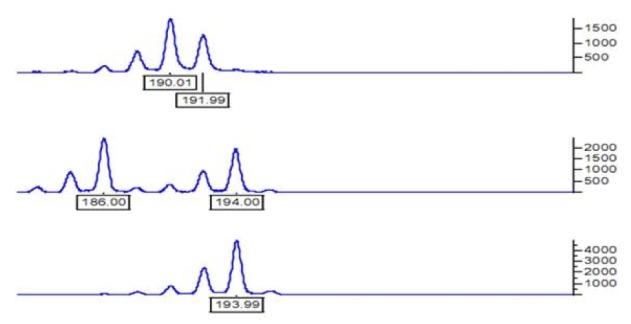
4. Bone maturity
Bone maturity determined from bone age, bone score and expected height were analyzed using the TWII method, in which pictures of the hand and the wrist are taken and 20 individual bones are analyzed, including the carpal bone, 1st, 3rd and 5th metacarpal bones and phalange as the RUS. Bone maturity was completed when the bone score reached 1000 points. The left hand and the wrist were X-rayed to measure the bone maturity of the receiving part. The devices were used the RF500-125 and a 10x10 inch film size using 20 mA radiation in 0.06 second and with a distance of 100 cm 50 KVP.
5. Physical fitness
Grip, back strength, sit-up, the sit & reach, standing long jump, repetitive side jump, standing up with one leg while closing eyes and Harvard step test were measured by the grip gauge (TKK, Japan) and the back strength gauge (TKK, Japan). To measure the sit & reach, a subject extends knees for the feet to completely touch the vertical surface of the device and then completely bends the upper body for 2 seconds with maximum stretching of the arms. The sit-up was measured by maintaining the knee angle of 140 degrees while a subject lies on the mat, touching the feet on the floor and raising the upper body to touch the knee with the elbow for 30 seconds. The standing long jump was measured twice measuring the distance between the starting point and the heel of the landing foot. The subject jumps forward from standing position without crossing the line. The longer distance was recorded at the precision of 0.1 cm. The repetitive side jump recorded the number of touching or crossing the tape when a subject jumps back and forth on 2 feet between 2 lines 35 cm apart. In standing on one leg while closing the eyes, the subject keeps standing on one foot while raising the other foot and putting both hands on the waist. The time until the balance lost was measured twice at 0.1-second interval and the average time was recorded. The modified Harvard step test, the subjects climbs on a block with a height of 30 cm for 3 minutes at a pace of 30 steps a minute. The pulses were recorded between 1 minute and 90 seconds, 2 minutes and 150 seconds and 3 minutes and 210 seconds during the restoration period and the PEI was calculated using the formula [PEI={Exercise time (second)/Total number of pulses for 3 times×2}×100].
6. Taekwondo training program
The Taekwondo training ran for 16 weeks and lasted for 50 minutes a day, 5 times a week with 5 minutes of warm-up and cool-down, including 40 minutes of center work. The warm-up consisted of stretching and auxiliary exercises like jumping and light running. The center work consisted of kicking, poomsae and basic movement.
Statistical analysis
Means and the standard deviations were calculated using SPSS version 18.0. A one-way ANOVA was used to determine the statistical differences in physical fitness before and after Taekwondo training as well as to assess the difference between groups in the IGF-1 polymorphism. The Scheffe method was adopted for post-hoc comparisons. The level of significance was set at 0.05 for the overall analysis.
RESULTS
The comparison of the allele frequency in the IGF-1 gene and the polymorphism
As shown in Table 1, 6 alleles were observed in the IGF-1 gene and the CA repeat distribution ranged from 16 to 21. The 18 CA repeat revealed the highest frequency of 50.0%, followed by 13.6% for the 20 CA repeat, 12.5% for the 17 CA repeat and 11.4% for the 19 CA repeat. 75.5% of the subjects had at least one 18 CA repeat which was considered as a wild type. Table 2 presents the analysis of the IGF-1 gene polymorphism and 11 subjects (25%) for the 18 CA repeat homozygote, 22 subjects (50%) for the heterozygote and 11 subjects (25%) for the 18 CA repeat non-carrier.
Table 1. The allele distribution of the IGF-1 for the children.
Table 2. The frequency in the IGF-1 gene polymorphism.
The comparison of physical fitness and growth index depending on the IGF-1 gene polymorphism
As shown in Table 3, there was no significant difference in the physical fitness parameters which depend on the gene polymorphism except for the back strength, standing long jump and standing on one foot while closing the eyes, which demonstrated consistent tendency to increase from homozygote and heterozygote to non-carriers groups.
Table 3. Comparison of physical fitness with IGF-1 gene polymorphisms.
Values are mean±standard deviation.
Table 4 shows the comparison of the body composition depending on the gene polymorphism. There was no significant difference in terms of body composition although there was a tendency for the non-carriers group to be high. Table 5 shows the comparison result depending on the gene polymorphism. There was no significant difference in most blood parameters. As shown in Table 6, the bone maturity due to the gene polymorphism did not indicate significant difference in bone score, bone age and height. However, the expected height in adult displayed a significant difference and was found to be significantly higher than the homozygote group (p<0.05).
Table 4. Comparison of body composition with IGF-1 gene polymorphisms.
Values are mean±standard deviation.
Table 5. Comparison of blood parameters with IGF-1 gene polymorphisms.
Values are mean±standard deviation.
Table 6. Comparison of skeletal growth with IGF-1 gene polymorphisms.
Values are mean±standard deviation, *Significant difference with the homozygote (p<0.05).
Changes in the growth index before and after Taekwondo training according to the IGF-1 gene polymorphism
Fig. 2 shows the analysis of the physical fitness before and after Taekwondo training according to the IGF-1 gene polymorphism. The right grip exhibits a significant difference among the groups while the homozygote group significantly increased compared to the non-carrier group (p<0.05). The standing on one foot while closing the eyes and the PEI significantly increased in the non-carrier group compared to the heterozygote group (p<0.05).
Fig. 2. Difference before and after the Taekwondo training for the physical fitness factors according to the IGF-1 gene polymorphisms *p<0.05.
Fig. 3 shows the analysis of the body composition before and after Taekwondo training according to the IGF-1 gene polymorphism. The homozygote group presented significant increase in the thigh circumference compared to the heterozygote group (p<0.001) and the non-carrier group (p<0.05).
Fig. 3. Difference before and after the Taekwondo training for the circumference depending on the IGF-1 gene polymorphisms *p<0.05, +p<0.001.
Fig. 4 shows the analysis of the blood before and after Taekwondo training according to the IGF-1 gene polymorphism. There was a significant increase in IGF-1 in the heterozygote group compared to the non-carrier group (p<0.05). The homozygote and the non-carrier group demonstrated significant decrease in glucose compared to the heterozygote group (p<0.05). The HOMA-IR exhibited significant decrease in the homozygote group compared to the heterozygote group (p<0.05). There was no significant difference among the groups although there was a tendency for the values to decrease.
Fig. 4. Difference before and after the Taekwondo training for the blood factor depending on the IGF-1 gene polymorphisms *p<0.05, **p<0.01, +p<0.001.
DISCUSSION
The IGF-1 gene expresses the gene polymorphism depending on the component of the promoter around the 5' UTR and the length of the repetition on the CA repeat of the IGF-1 gene promoter. The number and the frequency have been variably reported among different races because the CA repeat number exhibits the distribution from 10 to 24 [6]. There was a 40~60% of the 19 CA repeat among Cocasian [6,8] and a 32.6% of the 18 CA repeat among the African American [9]. Among Asians, Japanese shows 41.2% of the 19 CA repeat [10] and the Chinese demonstrated 36.3% of the 20 CA repeat [11]. Prior studies on the Koreans indicated that the 17 CA repeat revealed the highest frequency for the women in their menopause at 26.2% [12] while the 19 CA repeat was the highest for children and adolescents at 38.9% [13] and the obese male middle school students at 37.5% [14]. In addition, it was reported that the children with an average age of 9 and 10 years old showed that the 19 CA report was the highest at 40.9% [15] and 41.3% [16], respectively. The study cited the range of the CA repeat from 16 to 21 and the 18 CA repeat presented the highest frequency of 50.0%, followed by the 20 CA repeat and the 17 CA repeat at 13.6% and 12.5%, respectively. The result is contrary to prior studies due to some features concerning race and age.
The IGF-1 gene polymorphism affects muscular strength [17], positively affects the assimilation process of skeletal muscles [2], and acts as a factor in protein assimilation by the growth hormone [18,19]. It was proposed that the IGF-1 gene polymorphism played an important role in improving muscular strength, for the muscle volume largely depends on the IGF-1 gene polymorphism [17] but Kim [15] suggested otherwise even in muscular endurance and cardiovascular endurance. Furthermore, no difference was found among the gene polymorphism groups as a result of comparing the IGF-1 gene polymorphism and the physical fitness after playing basketball [20]. Meanwhile, Ahn and Kim [14] asserted that the homozygous group obese male middle school students showed high improvement in the grip and the sit-ups after complex exercise for 12 weeks after comparing the effect of the exercise on improving the physical fitness depending on the IGF-1 gene polymorphism. The grip (right) exhibited a significant difference among the gene polymorphism groups, while there was a significant increase (p<0.05) in the homozygote group compared to the non-carrier group, which is consistent to the positive effects of IGF gene on muscular strength or volume in prior studies [2,17]. In addition, standing on one foot while closing eyes and the PEI displayed significant difference among the groups, this means that there was a significant increase in the non-carriers group compared to the heterozygote group (p<0.05). Although the results suggest a tendency for Taekwondo training to affect physical fitness depending on the gene polymorphism, this training effects can not accepted the consistency.
Bones grow from birth to the age of 20, reaching the peak bone mass. Regular exercise during childhood and adulthood causes the osteoblasts in the human body to stimulate the bones and helps the bone's regeneration [21]. It is proposed that it is most effective to increase the peak bone mass during childhood to adolescence to prevent fracture due to osteoporosis [22]. Studies comparing the body composition, blood lipid factor and physical fitness level depending on the IGF-1 of children illustrated that the bone maturity of children do not have difference among the gene polymorphism groups [15]. On the other hand, the studies on the effects of a complex exercise depending on the IGF-1 gene polymorphism proposed that there was no difference in the expected height, bone score and bone age among the groups according to polymorphism [23]. Meanwhile, the analysis of bone among the children with an average age of 9 explained that the homozygous group revealed a high tendency [20]. The study did not indicate a significant difference in bone age and bone score depending on the gene polymorphism but the homozygote group demonstrated a relatively high tendency compared to the other 2 groups, which was similar to previous studies. The expected height among adults was significantly higher (p<0.05) for the non-carrier groups than the homozygote group. Prior studies established that the IGF-1 gene polymorphism affected the IGF-1 concentration in the blood and the weight and height at birth. The 19 CA repeat non-carriers group reported the lowest level [17]. Unlike some previous studies, the non-carriers group revealed a high tendency compared to the other 2 groups in body composition. A possible explanation is that the impact of the IGF-1 gene in body composition is very high because the gene affects the cell differentiation and the metabolic process [24]. It was also proposed that the non-carrier group of the IGF-1 gene highly increases the height, body fat, weight and the BMI of children in their growth period [25], the IGF-1 gene polymorphism seems to cause significant differences in the weight, BMI, body fat, waist and hip circumferences [26]. Kim et al. [20] pointed that the BMI and the WHR decreased for children who had played basketball for 3 months.
Meanwhile, the analysis of children with an average age of 9 years old confirmed no significant difference in the IGF-1 excretion in the blood, body composition, bone age and complex exercise depending on the IGF-1 gene polymorphism during the growth period. There was, however, an increase in body circumference and the subcutaneous fat thickness [23]. No significant difference was found among the groups after Taekwondo training for 16 weeks, however, there were a decrease in BMI and an increase in overall fat and subcutaneous fat thickness. In addition, the thigh circumference exhibited significant difference in the homozygote group (p<0.001) and the non-carriers group (p<0.01) compared to the heterozygote group. This suggests that kicking and basic exercise causes movement repetition in the lower body, which in turn increase thigh circumference after Taekwondo training. However, this means that IGF gene shows no critical effect on body composition.
Other studies argue that like the growth hormone, the IGF-1 concentration increases after the exercise [27,28] but is not largely depend on the exercise type or intensity or the concentration decreases [29,30]. Kim [23] concluded that there was no significant difference among the groups as an effect of the complex exercise for 12 weeks according to the IGF-1 gene polymorphism for children in their growth period but the homozygous group demonstrated an increasing tendency. The IGF-1 concentration in the blood rises after the exercise. The study shows similar results to previous studies in that the IGF-1 concentration in the blood displayed significant difference among the groups and significantly increasing in the heterozygote group (p<0.05), meaning that it depends on the exercise type and exercise frequency. The osteocalcin, the non-invasive differential susceptibility of the bone metabolism process, plays a very crucial role in the bone metabolism and is synthesized in the osteoblast as the vitamin K-dependent calcium-binding protein. Most of the substances are integrated into the bone stroma and some are separated into the blood [31]. There was no significant difference among the groups but there was an increase in osteocalcin after the exercise for all the groups.
The HDL-C, blood lipid profile, presented a tendency to increase after Taekwondo training for 16 weeks and the LDL-C, TC and TG indicated the opposite after Taekwondo training although no significant difference was found among the groups. The glucose significantly decreased in the homozygote and the non-carriers groups compared to the heterozygote group (p<0.05). The insulin decreased in the homozygote and the non-carriers group and increased in the heterozygote group without significant difference among the groups. The HOMA-IR reported significant difference among the groups while the homozygote group significantly decreased compared to the heterozygote group (p<0.05). Although this change showed within normal range, this change meant a positive response of insulin sensitivity to exercise training. This is partly similar with the results of Taekwondo training for 12 weeks where there was an increase in the blood HDL-C and decreases the LDL-C, preventing cardiovascular diseases and metabolic diseases like diabetes or hypertension and providing positive impact on the bone formation indicator and hormone [32]. It was expected that regular Taekwondo training would positively affect the improvement in the blood factor for children in their growth period.
The result above proposes that Taekwondo training may affect the physical fitness and the growth index depending on the IGF-1 gene polymorphism. In addition, regular Taekwondo training is expected to positively improve the physical fitness and the growth index of children in their growth period. However, it is confirmed that the difference between physical fitness and growth index according to the IGF-1 gene polymorphism after the Taekwondo training is not consistent as insufficient subjects number and training effects, requiring longitudinal researches for a sampling of more subjects in future investigation.
ABBREVIATIONS
- BMI
body mass index
- HDL-C
high density lipoprotein-cholesterol
- HOMA-IR
homeostatic model assessment-insulin resistance index
- IGF-1
insulin-like growth factor-1
- LBM
lean body mass
- LDL-C
low density lipoprotein-cholesterol
- TC
total cholesterol
- TG
triglyceride
- PEI
physical efficiency index
- WHR
waist hip ratio
Footnotes
CONFLICT OF INTEREST: The authors report no conflicts of interest.
References
- 1.WTF. World Taekwondo Federation member status. 2013. www.wtf.org.
- 2.Daughaday WH, Rotwein P. Insulin-like growth factors I and II. Peptide, messenger ribonucleic acid and gene structures, serum, and tissue concentrations. Endocr Rev. 1989;10:68–91. doi: 10.1210/edrv-10-1-68. [DOI] [PubMed] [Google Scholar]
- 3.Florini JR, Ewton DZ, Coolican SA. Growth hormone and the insulin-like growth factor system in myogenesis. Endocr Rev. 1996;17:481–517. doi: 10.1210/edrv-17-5-481. [DOI] [PubMed] [Google Scholar]
- 4.Barton-Davis ER, Shoturma DI, Sweeney HL. Contribution of satellite cells to IGF-I induced hypertrophy of skeletal muscle. Acta Physiol Scand. 1999;167:301–305. doi: 10.1046/j.1365-201x.1999.00618.x. [DOI] [PubMed] [Google Scholar]
- 5.Eliakim A, Scheett TP, Newcomb R, Mohan S, Cooper DM. Fitness, training, and the growth hormone-->insulin-like growth factor I axis in prepubertal girls. J Clin Endocrinol Metab. 2001;86:2797–2802. doi: 10.1210/jcem.86.6.7560. [DOI] [PubMed] [Google Scholar]
- 6.Vaessen N, Heutink P, Janssen JA, Witteman JC, Testers L, Hofman A, Lamberts SW, Oostra BA, Pols HA, van Duijn CM. A polymorphism in the gene for IGF-I: functional properties and risk for type 2 diabetes and myocardial infarction. Diabetes. 2001;50:637–642. doi: 10.2337/diabetes.50.3.637. [DOI] [PubMed] [Google Scholar]
- 7.Larsen LA, Grønskov K, Nørgaard-Pedersen B, Brøndum-Nielsen K, Hasholt L, Vuust J. High-throughput analysis of fragile X (CGG)n alleles in the normal and premutation range by PCR amplification and automated capillary electrophoresis. Hum Genet. 1997;100:564–568. doi: 10.1007/s004390050552. [DOI] [PubMed] [Google Scholar]
- 8.Frayling TM, Hattersley AT, McCarthy A, Holly J, Mitchell SM, Gloyn AL, Owen K, Davies D, Smith GD, Ben-Shlomo Y. A putative functional polymorphism in the IGF-I gene: association studies with type 2 diabetes, adult height, glucose tolerance, and fetal growth in U.K. populations. Diabetes. 2002;51:2313–2316. doi: 10.2337/diabetes.51.7.2313. [DOI] [PubMed] [Google Scholar]
- 9.Takacs I, Koller DL, Peacock M, Christian JC, Hui SL, Conneally PM, Johnston CC, Jr, Foroud T, Econs MJ. Sibling pair linkage and association studies between bone mineral density and the insulin-like growth factor I gene locus. J Clin Endocrinol Metab. 1999;84:4467–4471. doi: 10.1210/jcem.84.12.6179. [DOI] [PubMed] [Google Scholar]
- 10.Miyao M, Hosoi T, Inoue S, Hoshino S, Shiraki M, Orimo H, Ouchi Y. Polymorphism of insulin-like growth factor I gene and bone mineral density. Calcif Tissue Int. 1998;63:306–311. doi: 10.1007/s002239900532. [DOI] [PubMed] [Google Scholar]
- 11.Jiang DK, Shen H, Li MX, Jiang C, Yang N, Zhu J, Wu Y, Qin YJ, Zhou Q, Deng HW. No major effect of the insulin-like growth factor I gene on bone mineral density in premenopausal Chinese women. Bone. 2005;36:694–699. doi: 10.1016/j.bone.2005.01.013. [DOI] [PubMed] [Google Scholar]
- 12.Kim JG, Roh KR, Lee JY. The relationship among serum insulin-like growth factor-I, insulin-like growth factor-I gene polymorphism, and bone mineral density in postmenopausal women in Korea. Am J Obstet Gynecol. 2002;186:345–350. doi: 10.1067/mob.2002.120483. [DOI] [PubMed] [Google Scholar]
- 13.Ko MJ, Hwang TG, Lee JN, Chung WY. Analysis of cytosine adenine(CA) repeat polymorphism of the IGF-I gene and influence on serum IGF-I levels in healthy children and adolescents. Korean J Pediatr. 2006;49:1340–1347. [Google Scholar]
- 14.Ahn N, Kim K. Comparisons of 12 week combined exercise intervention-mediated changes of body composition, physical fitness, and metabolic syndrome risk factors according to IGF-1 gene polymorphism in obese adolescent boys. Korean J Obes. 2009;18:102–115. [Google Scholar]
- 15.Kim K. Comparison of body composition, blood lipid profiles, and physical fitness according to IGF-1 gene polymorphism in a child. Korean J Phys Educ. 2010;49:513–524. [Google Scholar]
- 16.Kim K. Association of IGF-I gene polymorphism with blood concentration of IGF-I, body composition, bone age and response to combined exercise program in teen-aged children. Korean J Sports Med. 2012;30:55–64. [Google Scholar]
- 17.Rietveld I, Janssen JA, Hofman A, Pols HA, van Duijn CM, Lamberts SW. A polymorphism in the IGF-I gene influences the age-related decline in circulating total IGF-I levels. Eur J Endocrinol. 2003;148:171–175. doi: 10.1530/eje.0.1480171. [DOI] [PubMed] [Google Scholar]
- 18.Lee YS, Kang SH, Lee SS. The effects of muscle resistance exercise on body composition, IGF-1 and myostatin. Korean J Phys Educ. 2006;45:359–368. [Google Scholar]
- 19.Fryburg DA, Barrett EJ. Growth hormone acutely stimulates skeletal muscle but not whole-body protein synthesis in humans. Metabolism. 1993;42:1223–1227. doi: 10.1016/0026-0495(93)90285-v. [DOI] [PubMed] [Google Scholar]
- 20.Kim K, Lee W, Lee S, Cheon W, Ahn N, Hong C. Association of responsiveness of body composition, physical fitness, and growth markers to basketball exercise with IGF-1 gene polymorphism in children. Korean J Phys Educ. 2011;50:307–319. [Google Scholar]
- 21.Pocock N, Eisman J, Gwinn T, Sambrook P, Kelly P, Freund J, Yeates M. Muscle strength, physical fitness, and weight but not age predict femoral neck bone mass. J Bone Miner Res. 1989;4:441–448. doi: 10.1002/jbmr.5650040320. [DOI] [PubMed] [Google Scholar]
- 22.Hansen MA, Overgaard K, Riis BJ, Christiansen C. Role of peak bone mass and bone loss in postmenopausal osteoporosis: 12 year study. BMJ. 1991;303:961–964. doi: 10.1136/bmj.303.6808.961. [DOI] [PMC free article] [PubMed] [Google Scholar]
- 23.Kim Y, Lm H, Park G. Effects of height and obesity on wage: gender differences. J Soc Sci. 2012;19:7–36. [Google Scholar]
- 24.Froesch ER, Hussain MA, Schmid C, Zapf J. Insulin-like growth factor I: physiology, metabolic effects and clinical uses. Diabetes Metab Rev. 1996;12:195–215. doi: 10.1002/(SICI)1099-0895(199610)12:3<195::AID-DMR164>3.0.CO;2-G. [DOI] [PubMed] [Google Scholar]
- 25.He Q, Karlberg J. Bmi in childhood and its association with height gain, timing of puberty, and final height. Pediatr Res. 2001;49:244–251. doi: 10.1203/00006450-200102000-00019. [DOI] [PubMed] [Google Scholar]
- 26.Voorhoeve PG, van Rossum EF, Te Velde SJ, Koper JW, Kemper HC, Lamberts SW, de Waal HA. Association between an IGF-I gene polymorphism and body fatness: differences between generations. Eur J Endocrinol. 2006;154:379–388. doi: 10.1530/eje.1.02101. [DOI] [PubMed] [Google Scholar]
- 27.Yoo J, Kim S, Kim M, Yoon S, Kim E, Lee E, Choi HN, Yoon J, Jee Y. The responses of testosterone, growth hormone, IGF-1, cortisol on resistance exercise of various intensities. Korean J Phys Educ. 2004;43:713–725. [Google Scholar]
- 28.Takarada Y, Nakamura Y, Aruga S, Onda T, Miyazaki S, Ishii N. Rapid increase in plasma growth hormone after low-intensity resistance exercise with vascular occlusion. J Appl Physiol (1985) 2000;88:61–65. doi: 10.1152/jappl.2000.88.1.61. [DOI] [PubMed] [Google Scholar]
- 29.Häkkinen K, Pakarinen A, Kraemer WJ, Newton RU, Alen M. Basal concentrations and acute responses of serum hormones and strength development during heavy resistance training in middle-aged and elderly men and women. J Gerontol A Biol Sci Med Sci. 2000;55:B95–B105. doi: 10.1093/gerona/55.2.b95. [DOI] [PubMed] [Google Scholar]
- 30.Raastad T, Bjøro T, Hallén J. Hormonal responses to high- and moderate-intensity strength exercise. Eur J Appl Physiol. 2000;82:121–128. doi: 10.1007/s004210050661. [DOI] [PubMed] [Google Scholar]
- 31.Bassey EJ, Rothwell MC, Littlewood JJ, Pye DW. Pre- and postmenopausal women have different bone mineral density responses to the same high-impact exercise. J Bone Miner Res. 1998;13:1805–1813. doi: 10.1359/jbmr.1998.13.12.1805. [DOI] [PubMed] [Google Scholar]
- 32.Byun JC. A comparative of lumbar BMD, bone markers hormone and immune function in trained and untrained children by Taekwondo. J Phys Growth Motor Dev. 2005;13:11–20. [Google Scholar]



